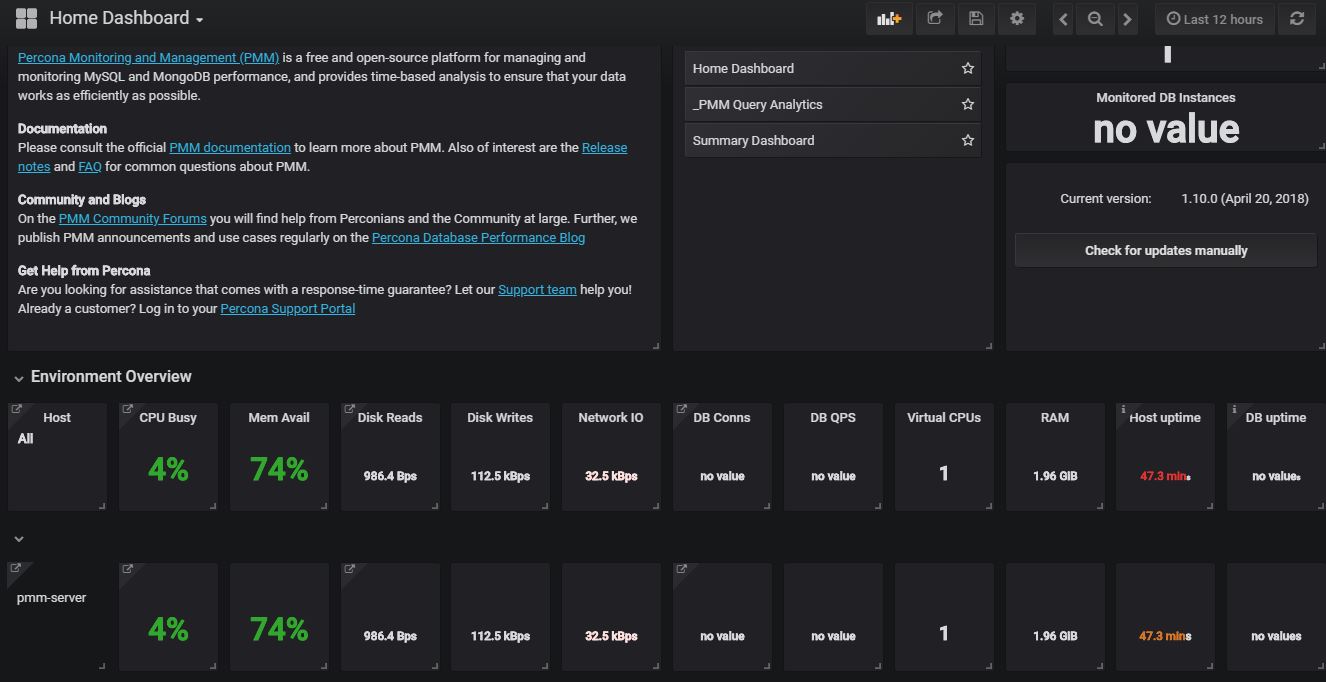Monitoring and Management of Percona XtraDB
For this tutorial, we will install Percona Monitoring and Management server (PMM server) on a separate node and pmm-client on each database node
Prerequisites
We have three (3) different ways of running PMM server 1- Running PMM server via Docker 2- Running PMM server as a Virtual Appliance 3- Running PMM server Using AWS Marketplace
For the purpose of this tutorial, we we be running PMM server via Docker. So you will need node running Docker. I will not convert the installation of docker in this tutorial.
Getting the PMM server up and running
Download the percona/pmm-server image
Login to your docker node and run
docker images
output
root@docker2001:~# docker images REPOSITORY TAG IMAGE ID CREATED SIZE nginx latest ae513a47849c 9 days ago 109MB ubuntu latest 0458a4468cbc 3 months ago 112MB
In my case I have only 2 images no percona/pmm-server image. Lets go ahead and download the percona/pmm-server image by issuing the command
docker pull percona/pmm-server:latest
Now if we run again the commande "docker images" we should see the percona/pmm-server image
Output
root@docker2001:~# docker images REPOSITORY TAG IMAGE ID CREATED SIZE nginx latest ae513a47849c 9 days ago 109MB percona/pmm-server latest 62f64eeb6eec 2 weeks ago 842MB ubuntu latest 0458a4468cbc 3 months ago 112MB
Start the percona/pmm-server container
Now that we have the image available we are going to create the pmm-data container and start it using the scripts below
Script to create the container
#!/bin/bash docker create \ -v /opt/prometheus/data \ -v /opt/consul-data \ -v /var/lib/mysql \ -v /var/lib/grafana \ --name pmm-data \ percona/pmm-server:latest /bin/true
Script to start the container
#!/bin/bash docker run -d \ -p 80:80 \ --volumes-from pmm-data \ --name pmm-server \ --restart always \ percona/pmm-server:latest
Please refer to Docker documentation for the different options used in both scripts such as -v, -p and so on
make both scripts executable my running
chmod +x pmm-data.sh Chmod +x pmm-run.sh
Run both scripts
./pmm-data.sh ./pmm-run.sh
Now check the list of running containers
docker ps
Output
root@docker2001:~# docker ps CONTAINER ID IMAGE COMMAND CREATED STATUS PORTS NAMES dfff2958b2b3 percona/pmm-server "/opt/entrypoint.sh" 2 minutes ago Up 2 minutes 0.0.0.0:80->80/tcp, 443/tcp pmm-server
Open a browser and type in your IP address to access the pmm-server dashboard
Install Pmm-client on each node
We are going to use the same nodes we used in How to install Percona XtraDB Cluster. We have a total of 3 nodes (db1,db2 and db3)
Process is the same, so I will be doing the first node (db1)
login to db1, run
sudo apt-get update sudo apt-get install pmm-client
Connect PMM client to PMM server
To connect each pmm client to PMM server we use the command "pmm-admin config --server IP_adress_of_server" in our case the command will be
pmm-admin config --server 10.192.0.96 OK, PMM server is alive.
PMM Server | 10.192.0.96 Client Name | db1 Client Address | 10.192.0.87
10.192.0.96 being our PMM server IP addres
Note: if your PMM server has a username and a password the command to use is
pmm-admin config --server pmm_server_IP --server-user username --server-password password
